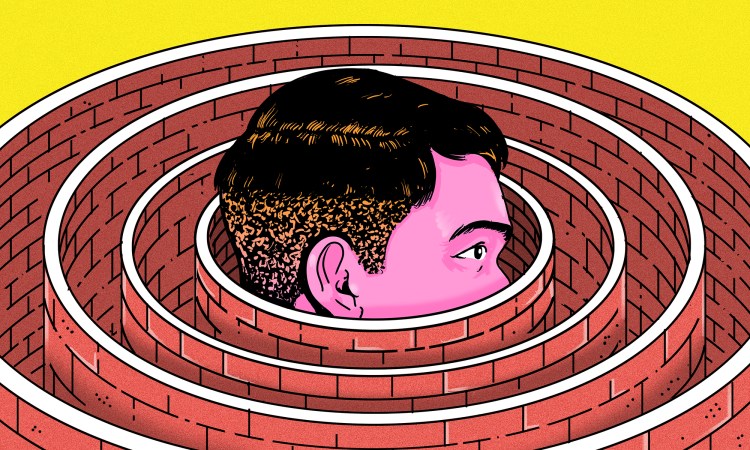
This post is part of TED’s “How to Be a Better Human” series, each of which contains a piece of helpful advice from people in the TED community; browse through all the posts here.
To be human is to get defensive. When we’ve been questioned or criticized at work, it’s fair to say that almost all of us — save for, perhaps, the Dalai Lama and other equanimous souls — have gotten irritated, retreated into silence, or said something cutting in response. And because it is so normal to get defensive, we tend to write it off as no big deal. Jim Tamm, however, begs to differ.
Former judge Tamm spent 25 years working through other interpersonal conflicts, including mediating more than 1,000 employment disputes, and he currently trains consultants to teach collaboration skills. So what does defensiveness have to do with collaboration? Tamm has come to believe that defensiveness is the major obstacle that prevents people from working well together. “There is nothing that will help you become more effective at building collaboration than better managing your own defensiveness,” he says in an interview.
While it’s close to impossible to completely eliminate getting defensive during stressful moments, you can become aware of your own reactions and have an action plan in place when you notice them. “Any time you’re getting defensive, you’re getting less effective. When you get defensive, your thinking becomes rigid and you simply become stupid,” says Tamm, also the author of the book Radical Collaboration.
Why is defensiveness such an obstacle to collaboration? When we get defensive, “we put way more into self-preservation than we do into problem-solving,” Tamm says. “We’re trying to prove that we’re right rather than search for creative solutions.” When this happens in a workplace, it can be a recipe for chaos and failure. Such impulses are especially harmful for bosses, managers and those in power. That behavior hurts more than just the defensive person. When we get defensive, adds Tamm, “we invite everyone else in the room to get defensive, too.”
Of course, it can be difficult to recognize defensiveness in ourselves, and that’s because there are underlying emotions at play. When a person becomes defensive, they might appear to be putting on protective armor and gearing up for battle, but they’re usually masking their fear. “Defensiveness does not protect us from other people,” says Tamm. “It defends us from fears we don’t want to feel.” Those fears can include thoughts about your own significance, your competence and your likeability. Your defenses might come up due to imposter syndrome — like when you’re scared not looking smart enough or that you’re a subpar employee or a bad boss.
For example, let’s say you’re worried about a performance review. When your manager gives you some constructive criticism, you may offer excuses or become angry or brusque. But Tamm says these behaviors are masking your real problem, which could be your fear of not getting the raise or promotion that you feel you deserve or even your fear of being fired. “Our defensiveness helps us hide our fears from ourselves,” he says, and it erroneously serves to convince you that the fears you have aren’t true.
OK, now that we understand the dangers of defensiveness, here’s what we can do about it. You can start by learning to spot the warning signs of defensiveness in yourself. When you feel yourself experiencing them, pay attention and take action. According to Tamm, here are the 10 most common warning signs that you may be getting defensive: A spurt of energy in your body; sudden confusion; flooding your audience with information to prove a point; withdrawing into silence; magnifying or minimizing everything; developing “all or nothing” thinking; feeling like you’re a victim or you’re misunderstood; blaming or shaming others; obsessive thinking; and wanting the last word.
Tamm recommends looking back on any charged conversations, disagreements or conflicts — minor and major — from your life, and finding the patterns of behavior you engage in when you get defensive. Perhaps a minor tiff at work made you default to “all or nothing” thinking, and suddenly you felt ready to quit. Or, a single question from your partner about where the soup pot is located gets magnified into “You never know where anything is because you never liked this apartment.” If you have difficulty determining your own signs of defensiveness, ask for feedback from your family, friends or trusted colleagues. “Usually, other people spot our defensiveness before we do,” says Tamm.
Why is internal observation so important? “Most of us are not sufficiently in tune with our fear to do anything about it until it’s too late,” says Tamm. “If we know what our signs of defensiveness are, they can become our own personalized early warning system. For example, I noticed that when I get defensive, my breathing becomes faster, I tend to talk much louder, and I usually feel very misunderstood.”
Creating your own warning system for defensiveness involves a few simple steps: Noticing, taking action, and letting go. Whenever you recognize one of your own warning signs — for example, obsessive thinking or confusion — acknowledge to yourself that you’re getting defensive by saying something like “It feels like I’m becoming defensive.” This is extremely important. Tamm points, “If you don’t notice that you’’re getting defensive, you’re not going to take any other action.”
Next, slow down your physiology in some way. That could mean taking a few deep breaths, being aware of your feet on the ground, or — if you can — going for a walk. Focusing your attention outward is like hitting a reset button on your defensiveness. At the same time, try to observe what you’re saying to yourself. If you find that you’re criticizing yourself for your defensiveness or for your lack of keeping cool, ask yourself something like “Is this helping me right now? What behavior would be more helpful?”
Then, create an action step to counteract any damage that your defensiveness may cause. If you typically go quiet and sulk, for instance, you may decide instead to ask a question or share what you’re feeling. One way to create a psychologically safe environment for yourself — and others — is when you demonstrate your vulnerability. This can be accomplished by sharing something like “I feel like I’m getting defensive here, so let me take a step back.” Or, if your defensiveness sign is bombarding your teammates with information to prove your point, you could consciously pause for 15 seconds and let others finish speaking first.
In his TEDx talk, Tamm shares a memorable example of an action step. He says, “One woman’s warning sign was always wanting the last word. So she got this image of herself standing in the conference room doorway, throwing in the last word, and slamming the door. [Picturing it] was a way of not only reminding her what she was doing but also lightening up her mood a little bit.”
Once you’ve taken your action step, you’ll find that you have an easier time letting go of your defensiveness and examining the situation — and your coworkers — with fresher, calmer eyes. Your physical and emotional selves will most likely be in a different place than when you first started getting defensive. Practice your action step until it becomes automatic, suggests Tamm.
Be patient: Noticing and managing your defensiveness takes practice. Find times — maybe with your family or friends — when you can rehearse your action steps so you’ll be ready when you most need them. Remember, says Tamm: “If you can stay non-defensive, you can always be more effective.”
Watch his TEDxSantaCruz Talk here:













